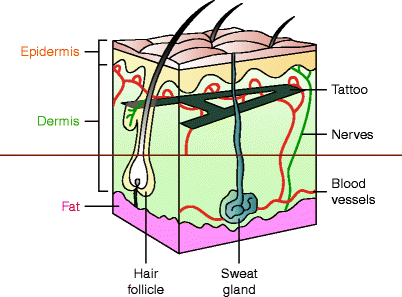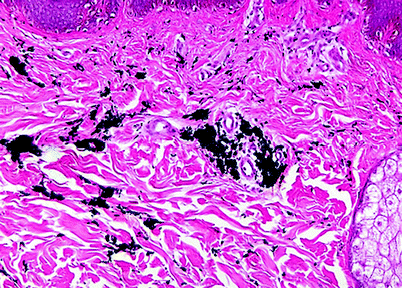Tattoos are a long-standing part of human culture.
Techniques used in tattooing have evolved over the centuries.
Although 24% of Americans between the ages of 18–50 years have at least one tattoo, 28% of people who get tattoos regret the decision within the first month.
The three lasers most commonly used are the Q-switched Nd:YAG, Q-switched Ruby, and Q-switched Alexandrite.
Potential side effects of using lasers in the removal of tattoos include discoloration, redness, scarring, and rarely, stimulating allergic reactions.
Introduction
A tattoo is a mark created by pigments that permanently reside in the dermal layer of the skin. The word tattoo has roots from the Polynesian word “ta” which means “to strike” and the Tahitian word “tatau” which means “to mark.” The techniques of tattooing have changed over the years, but the basic principle remains the same. Dyes are manually applied through breaks in the skin. By embedding the various pigments below the epidermis, the pigments resist sloughing due to the natural growth cycle of the skin, thus offering permanence. In the older methods, dye-tipped needles were gently struck by stones and hammers to introduce the dye into the skin. Today, electrical tattoo machines utilize high-speed needle injections that minimize time and pain.
In the United States, an estimated 7–20 million people have at least one tattoo.1 In a recent study, the prevalence of tattoos among Americans aged 18–50 years old was found to be 24%.2 Reasons for tattoo application include: fashion, peer pressure, rebelliousness, and romance. For some individuals, regret appears as quickly as the initial decision to get a tattoo. Approximately 28% of people who get tattoos regret the decision within the first month. While the minimum age to obtain a tattoo is 18 years old, 71% of people requesting tattoo removal have had the ink applied when they were under the minimum age. The most common reason to seek tattoo removal was to further enhance self-esteem by freeing oneself from the stigmatizing lesion that was the source of many years of regret. In addition, tattoo owners felt their marks were socially discrediting, perceived pressure by family members to remove them, and believed improvement in employment opportunities would result after removal.3 On average, actual tattoo removal occurred 14 years later. Much of the delay can be attributed to perceived high financial costs, physical pain, and risk of permanent disfigurement associated with removal. Also, many potential patients admit that they were unaware of the availability of treatment options to remove their tattoo.4
Historical Perspectives
As evidenced by “Ötzi the Ice Man,” a 5,000-year-old man bearing 57 tattoos whose body was discovered in 1991, tattoos have been a part of human culture for a very long time. Some anthropologists even speculate that the art of tattooing began as early as 12000 B.C. The purpose of tattoos has varied from perceived therapeutic benefits and religious or tribal identification symbols to self-expressions of uniqueness and impulse. Regardless of their age or purpose, tattoos are a large part of human culture today and are becoming more and more popular.
The first tattoos from thousands of years ago were created in a rough manner. During bereavement ceremonies as signs of grief, primitive humans of the Stone Age (12000 B.C.) slashed their skin and rubbed ash into the wounds.5 It is highly unlikely that the detail of the designs resembled anything near the tattoos that we see today – although a few amateurs come close. The discovery of crude needles and pigment bowls in caves in France, Spain, and Portugal provide circumstantial evidence that decorative tattooing can be traced back to the Bronze Age (8000 B.C.). More well known older techniques were practiced elsewhere in the Ancient world. The Japanese utilized a hand-based tattooing technique that involved elaborate needle-tipped bamboo handles. Samoans, among many other Pacific cultures, used wooden hand tools such as a bone-tipped rake and a striking stick. The ancient Thai employed a tool that closely resembles the electric tattoo devices of today. They used a long brass tube with a sliding pointed rod that ran down the center.
Thomas Alva Edison, the famous inventor of the light bulb, played an unexpected role in the development of the tattoo. In 1891, Samuel O’Reilly modified Edison’s autographic printer to become the electric tattoo machine of today. It was a steel instrument that utilized needles that traveled in a vertical direction to pierce the skin at a rate up to 3,000 times/min.
Techniques of Tattooing
In order for a tattoo to be permanent, the dye must be placed at a certain location within the dermis – too superficial and it will be sloughed off in the epidermis; too deep and it will be taken up by lymphatics. Risks of unsterile tattooing techniques include transmission of bacteria, hepatitis B, hepatitis C, syphilis, and HIV. |
The tattoo is actually the appearance through the epidermis of the ink located in the dermis. During the tattoo process, needles are dipped in various inks. The electric tattoo device injects ink particles from the epidermis to a constant depth (usually 1 mm) below the dermal-epidermal junction (Fig. 1). As part of the skin’s natural growth cycle, the epidermis is continually sloughed off. In the layers of the dermis, macrophages recognize the dye particles as foreign and attempt to remove the molecules. However, most of dye is captured or ignored and remains in the dermis. Therefore, it is essential that the dye reach the dermis in order to become a permanent mark.


Fig. 1
Placement of tattoo ink within the dermis
In addition, it is important that the dye not be injected too deeply into the dermis. More commonly reached by amateur-level tattoo artists, these greater depths will increase the likelihood of the dye being carried away by body fluids or for the tattoo to be accompanied by scarring. This can lead to blurring of the tattoo and reduction of its visualization.
Obtaining a tattoo carries with it inherent risks. There have been reports that non-sterile tattooing practices have led to the transmission of infectious organisms such as bacteria, syphilis and hepatitis B; furthermore, there is also the potential for transmission of other blood-borne pathogens such as HIV and hepatitis C.6
Allergenicity
Additives such as PPD can be mixed with tattoo dye, causing allergic reactions in patients. Allergic or pruritic reactions to tattoos can be linked to certain colors used in the design. No dye used in tattooing is FDA approved for deposition into the dermis. |
Some patients have allergic reactions to either the pigments in the tattoo or to the additives that can be mixed in with the dye. Even though 2001 marked the first report of an adverse reaction following the application of a “black” henna tattoo darkened with paraphenylenediamine (PPD)-based chemicals, the notoriety of PPD had been previously established. In the 1930s, the practice of tinting the eyelashes and eyebrows with PPD dye was common. Many adverse reactions to PPD became apparent, with some women suffering serious blistering reactions, blindness, and even death, most notably to the product “Lash Lure.” Since there were no laws in place to regulate these products, cosmetic companies were not liable. By 1938, the Food, Drug, and Cosmetic Act was initiated with the first mandate: to remove “Lash Lure” from the American market and ban the use of PPD on skin.7
Other allergic reactions associated with tattoos can be linked to the specific color of pigment that was injected into the skin. There have been numerous reports of patients with known allergies to mercury or cobalt experiencing type IV hypersensitivity allergic reactions in areas tattooed with red or blue pigment, respectively.8 There are many common allergenic substances included in common tattoo dyes (Table 1).
Table 1
Tattoo pigments and their common ingredients
Dye color | Dye content |
|---|---|
Black | Carbon |
Red | Mercury sulfide |
Blue | Cobalt aluminate |
Brown | Hydrate of iron oxide |
Green | Chromium oxide |
Lilac | Magnesium |
White | Titanium oxide |
Yellow | Cadmium sulfide |
It is important to note that tattoo pigments have not FDA approved for intradermal injection. Nevertheless, there have been dramatic advances in the industry of body art, including the development of a biodegradable and bioabsorbable organic dye encapsulated in synthetic polymer. The tattoo is permanent; yet, when targeted with a laser, the beads disintegrate, exposing the ink to be resorbed into the body, thereby completely removing the tattoo.9
Methods of Removal
The most common medical techniques currently used for tattoo removal are laser surgery, surgical excision, and dermabrasion. Complications of these procedures, though rare, include discoloration, incomplete removal, scarring, or infection. Topical products that lighten naturally pigmented skin are generally not meant for tattoo removal, although current research is ongoing. |
Prior to current medical technologies, there was not much available to the patient requesting removal of their tattoo. The patient was offered the choice of harsh exfoliation techniques, chemical peels, thermal means, cryosurgery, or surgical resection. In lieu of medical treatment, many patients today still opt for covering up the tattoo with concealing makeup, or even voluntarily obtaining more tattoos in an attempt to modify or camouflage the original tattoo into a new, often larger design.
Each tattoo is unique; so must each removal technique match the demands of each individual situation. Tattoos that are professionally applied tend to penetrate the deeper layers of the skin at uniform levels (Fig. 2). This uniformity allows dermal surgeons to use techniques that remove broader areas of inked skin at the same depth.


Fig. 2
Tattoo granules present in the dermis prior to treatment
Currently, the most common tattoo removal techniques employed by dermatological professionals are laser surgery, surgical excision, and dermabrasion.
Laser surgery
The tattoo is treated by targeting selective pigments with a high-intensity laser beam. The type of laser used generally depends upon the colors to be removed. This modality offers a highly effective approach with minimal side effects, although frequently necessitates several treatments for complete removal.
Surgical excision
The tattoo is cut out and either sutured or allowed to heal, depending on size. The efficacy of this technique is highly dependent upon the individual surgeon, the size of the area to be resected, the tension of the skin in the area, and the individual’s tendencies toward scarring or developing a keloid.
Stay updated, free articles. Join our Telegram channel

Full access? Get Clinical Tree








